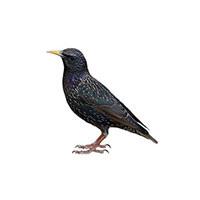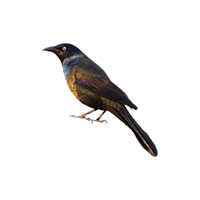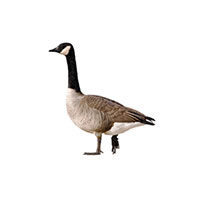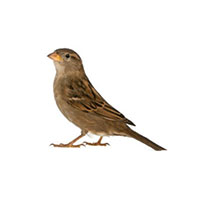Starlings in Wisconsin
Starlings are boisterous, loud, and they travel in large groups. They race across fields or sit high on wires or trees making a constant stream of whistles.
Starling Diet
Starlings eat a varied diet of insects, berries, and seeds. In the summer months, they will choose beetles, grasshoppers, flies, caterpillars, spiders, snails, earthworms, and other invertebrates. In fall and winter, they will eat a wide variety of berries, fruits, and seeds. They feed on the ground on lawns, fields, sidewalks, and parking lots.
Starling Habitat & Nesting
Starlings are an agricultural pest of standing crops, but will also flock into cities in large numbers. They prefer to nest in wooded, shaded areas, but often congregate and go looking for food and nesting materials around people. Nests are constructed with twigs, grass, leaves, trash, and other debris. The male establishes the territory and chooses the nest site, and then sings to attract a mate. While the construction of the nest is started by the male, the female completes it. When a female arrives, the male perches next to the nest site and sings, often waving his wings. The males often have more than one mate.
Starling Mating & Life Cycle
Starlings can rear up to two broods a year, in April and May. Breeding can extend into June and July if conditions are favorable. Each clutch usually consists of four to six greenish-white to bluish-white eggs. Incubation is by both parents for about 12 days. Once hatched, both parents feed the nestlings, and the young stay in the nest for about three weeks.
Starling Damage
The problem for home and property owners is that starlings congregate in such large numbers and prefer areas that are often populated. Bird droppings cause property damage because they contain elements that can eat away at pavement, asphalt, and metal. Dried bird droppings release dust that can get into homes and have adverse health effects, particularly to those who suffer from breathing issues such as asthma. Most species prefer to nest in forests; however, there are few that will build around your home, which can bring in parasites, cause damage from the materials or even create fire hazards from old, dried, abandoned nests. They typically return to the same place year after year to nest. Additionally, they often carry ticks, mites, and other parasites that, given their nest-building habits, can transfer to people.
Starling Control
Bird Control Services provides customized solutions to address bird concerns through removal, exclusion, and deterrence. Factors that determine the best method of control include an area of application, bird species, location, access. Spikes, netting, and electrical deterrents are the most commonly used solutions.
If issues with starlings arise, count on a professional pest management service to take care of the problem knowledgeably and successfully. Bird services are limited to commercial clients.
Need help with Starlings?
We'll call you! Leave your information below.





